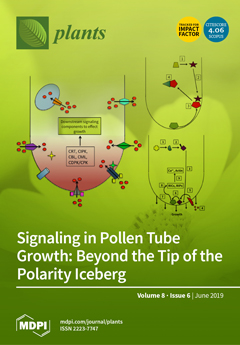Rice husk has been exploited as a potential source of allelochemicals. In this study, four bioactive compounds including momilactone E (ME), 7-ketostigmasterol (7KS), momilactone A (MA), and momilactone B (MB) were isolated by column chromatography (CC) to yield 2.7, 0.3, 11.7, and 8.3
[...] Read more.
Rice husk has been exploited as a potential source of allelochemicals. In this study, four bioactive compounds including momilactone E (ME), 7-ketostigmasterol (7KS), momilactone A (MA), and momilactone B (MB) were isolated by column chromatography (CC) to yield 2.7, 0.3, 11.7, and 8.3 mg/kg rice husk, respectively. The structures of the isolated compounds were identified and confirmed by spectroscopic techniques consisting of
1H and
13C nuclear magnetic resonance (NMR), electrospray ionization mass (ESI), high-resolution mass spectrometry (HR-MS) and infrared spectroscopy (IS). An advanced quantitative method for MA and MB was achieved to increase the detectable yields of MA and MB in rice husk to 51.96 and 42.33 µg/mL, respectively. The inhibitory activities of MA, MB, ME, and 7KS were examined on lettuce (
Lactuca sativa), barnyard grass (
Echinochloa crus-galli), and tall goldenrod (
Solidago altissima) in bioassays. The allelopathic activities of ME and 7KS were compared with those of potent phytoalexin momilactones A (MA) and B (MB), and the standard
p-hydroxybenzoic acid (
pHA). Results showed that both MA and MB exhibited stronger inhibitory activity than ME and 7KS. MB exerted greater inhibitions than MA but the mixture of MA and MB (1:1,
v/
v) possessed a similar level of inhibition to MB. On the other hand, although ME and 7KS presented non-significant inhibition, their mixture of ME-7KS (1:1,
v/
v) displayed a remarkable inhibition on the growth of
S. altissima. Findings of this study revealed that MA, MB, and the mixture ME-7KS had the potential to control the invasive plant
S. altissima and the noxious paddy weed
E. crus-galli in vitro, but their mode of actions should be further investigated.
Full article






